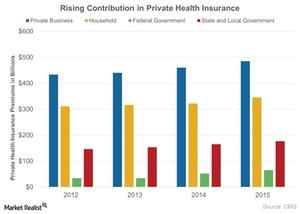Rising Costs Are a Major Issue in the Healthcare Sector
The US economy is dealing with rising healthcare costs. The national healthcare expenditure grew 5.8% to $3.2 trillion in 2015 or $9,990 per person.
May 25 2017, Published 12:46 p.m. ET

Healthcare sector in the US
In a recent interview with Wall Street Week on May 12, 2017, Cleveland Clinic CEO Dr. Toby Cosgrove shared his views on how rising costs and technological advancement could impact the future of healthcare in the US. He also spoke about how life expectancy continues to grow with the innovation of new medical technology.
Rising healthcare cost in the US
Currently, the US (SPY) (QQQ) economy is dealing with concerns about rising healthcare costs. According to the CMS database, the national healthcare expenditure grew 5.8% to $3.2 trillion in 2015 or $9,990 per person. The national healthcare expenditure accounted for ~17.8% of the GDP as of 2015.
According to Cosgrove, individuals need to understand what causes large and persistent annual increases in healthcare costs in order to improve the sector.
Let’s look at rising contributions to private healthcare insurance premiums in the following chart.
Rising expenditure on healthcare
National health spending is expected to grow at an average rate of 5.6% per year between 2016 and 2025. Spending is expected to increase 4.7% per year on a per capita basis, according to the CMS database. Private health insurance spending also grew 7.2% to $1,072.1 billion in 2015 or 33% of the total national healthcare expenditure.
According to Cosgrove, two main factors are leading to higher healthcare costs in the US:
- aging population
- increased cost to maintain overall health
Rising deductions and insurance premiums
Family plan premiums for private employer-based health insurance grew at an average rate of 7.3% per year between 2003 and 2013, according to a report by the Common Wealth Fund. Employee premium contributions grew at an average of 9.3% per year during the same period.
The report also mentioned that deductibles for all sizes of firms more than doubled during the same period. As a result, premiums and deductibles increased the combined share of an average family’s income. Rising healthcare costs are clearly creating challenges for average US households.
Government’s role in reducing the cost
According to Cosgrove, the government has a significant role to play legislatively and administratively to make the healthcare sector (XLV) (VHT) more efficient. The efficiency will result from hospitals working together and bringing about consolidation in the healthcare sector (IYH). With consolidation in the healthcare sector, purchasing power should help bring down the cost.
Cosgrove also feels that regulation burdens should be reduced because it results in unnecessary costs and human resources.
In the next part, we’ll look at technological innovation in healthcare, which will likely set the course for the healthcare sector in the future.
